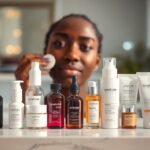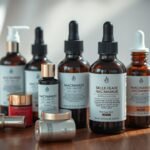
Over the years, I have come to realize that hyperpigmentation is a common skin condition that affects many individuals, particularly those with darker skin tones. By understanding its causes—such as sun exposure, hormonal changes, and inflammation—you can take proactive steps toward treatment. In this blog post, I will explore effective treatments and tips tailored for your skin type, empowering you to embrace your unique beauty while working towards an even skin tone.
Many individuals with darker skin tones experience hyperpigmentation, a condition characterized by the darkening of certain areas of the skin due to excess melanin production. In my experience, understanding the causes such as sun exposure, hormonal changes, and skin injuries is important for effective management. You deserve to know the best treatments, including topical treatments, laser therapy, and natural remedies, that can help even out your skin tone and restore your confidence. Join me as I probe into the nuances of this condition and explore tailored solutions for your needs.
Key Takeaways:
- Hyperpigmentation occurs when excess melanin is produced, leading to dark patches on the skin.
- Darker skin tones are more prone to certain types of hyperpigmentation, including post-inflammatory hyperpigmentation (PIH) following skin injuries.
- Common causes of hyperpigmentation include sun exposure, hormonal changes, certain medications, and skin injuries.
- Prevention strategies for hyperpigmentation include the regular use of sunscreen, wearing protective clothing, and avoiding peak sun hours.
- Treatments for hyperpigmentation may include topical agents like hydroquinone, vitamin C, and retinoids, as well as procedures such as chemical peels or laser therapy.
- Consulting with a dermatologist is highly advised for personalized treatment options and to avoid potential side effects from harsh treatments.
- Maintaining a consistent skincare routine can help brighten hyperpigmented areas over time and improve overall skin texture.
Key Takeaways:
- Hyperpigmentation occurs when excess melanin production leads to darker skin patches.
- Common causes include sun exposure, hormonal changes, certain medications, and skin injuries.
- Darker skin tones can be more prone to post-inflammatory hyperpigmentation following acne or other skin conditions.
- Treatment options vary and may include topical agents like hydroquinone, vitamin C, and retinoids.
- Professional options such as chemical peels, laser therapy, and microdermabrasion can also effectively reduce hyperpigmentation.
- Preventive measures include protecting skin from sun exposure with sunscreen and wearing protective clothing.
- Consulting with a dermatologist is advisable to tailor a treatment plan suitable for individual skin types and concerns.
The Biological Mechanisms of Hyperpigmentation in Darker Skin
The processes behind hyperpigmentation in darker skin involve complex biological mechanisms that dictate how skin responds to various stimuli. In darker skin tones, the presence of higher melanin levels can lead to pronounced dark spots and patches due to an increase in production triggered by factors such as UV exposure and inflammation. Understanding these processes provides insight into how hyperpigmentation can manifest differently across various skin types and tones.
Melanin Production and Its Role
Melanin is the pigment responsible for skin color, and its production is influenced by genetic and environmental factors. Under normal circumstances, melanocytes in the skin produce melanin in response to UV radiation. However, in certain conditions, these cells can become overactive, leading to increased melanin synthesis. This heightened production can create areas of hyperpigmentation, often exacerbated by the skin’s inflammatory response to irritants or injuries.
Genetic Factors Influencing Skin Tone
Your genetic predisposition plays a significant role in determining your skin’s reaction to hyperpigmentation. Variations in genes that regulate melanin production can affect how much pigment is formed and the overall distribution across your skin. Some individuals may have a genetic tendency to produce more melanin, while others may be more prone to developing pigmentation disorders. Recognizing these genetic influences can help in tailoring effective treatments.
- Genetic predisposition contributes significantly to skin tone and sensitivity.
- Variations in genes associated with melanin production affect pigmentation levels.
- Skin type determines response to hyperpigmentation triggers such as sun exposure.
- Understanding your genetic background enables the identification of tailored treatments.
Darker skin often contains a higher concentration of melanin, making it more susceptible to hyperpigmentation from skin trauma like cuts, acne, or eczema. Genetic markers may indicate a predisposition to certain skin conditions, including those that lead to increased melanin production. Dissecting these genetic factors can assist dermatologists in advising patients more effectively on treatment options suited for their unique skin profile. Recognizing the significance of genetic influence broadens the understanding of your skin’s behavior and the importance of personalizing care.
- Genetic markers could indicate predispositions to hyperpigmentation.
- Higher melanin levels in darker skin necessitate customized treatment plans.
- Increased risk for certain skin conditions can be linked to unique genetic backgrounds.
- A deep understanding of your genetic makeup can enhance treatment efficacy.
The Biological Mechanism of Hyperpigmentation in Darker Skin Tones
Understanding the biological mechanism behind hyperpigmentation is key to comprehending its prevalence in darker skin tones. This condition occurs when there is an overproduction of melanin, leading to patches or spots of darker skin. Factors like sun exposure, hormonal changes, and skin trauma can trigger this overproduction. In darker skin, the structural composition of melanosomes, the organelles that produce melanin, influences how pigment is deposited in the skin, resulting in varying patterns of hyperpigmentation.
Melanin Production and Distribution
Melanin is produced by specialized cells called melanocytes, which are more abundant in darker skin. These melanocytes generate melanin in response to environmental triggers—primarily ultraviolet (UV) rays. The distribution of melanin varies not just by the amount produced but also by how efficiently it is transferred to surrounding skin cells, known as keratinocytes. When this process is out of balance, the risk for hyperpigmentation increases.
Genetic Factors Influencing Skin Color
Your genetics play a significant role in determining your skin color and predisposition to hyperpigmentation. Variations in certain genes can influence the quantity and quality of melanin produced, as well as the size and function of melanocytes. For instance, specific alleles associated with increased melanin production can lead to a more pronounced response to sun exposure. This genetic makeup often dictates how your skin reacts to potential triggers for hyperpigmentation, ultimately determining your unique skin tone. Perceiving this interaction between genetics and skin health offers insights into personalized treatment approaches.
- Understanding your genetic factors can unveil predispositions to hyperpigmentation.
- Higher melanin content can cause enhanced skin defense against UV rays but may also predispose to dark spots.
- Where you see dark patches, consider your family history of skin conditions.
Delving deeper, it’s fascinating to learn how various ethnicities exhibit different responses due to evolutionary adaptations to sunlight exposure. For example, people from regions with high UV exposure tend to have genes that promote increased melanin to protect against skin damage. Furthermore, this genetic variance contributes to the complexities of treatment and prevention strategies tailored to various skin types. Perceiving the intricate dance of genetics and external factors enables a more holistic approach to managing hyperpigmentation.
- Adaptations to UV stress reflect in your skin’s genetic makeup.
- Understanding your ancestry can illuminate patterns of hyperpigmentation.
- Melanin production not only protects but also shapes your unique skin tone.
Common Triggers and Risk Factors for Hyperpigmentation
Understanding the various triggers and risk factors for hyperpigmentation can help you manage and prevent further skin issues. Common factors include:
- Sun exposure
- Hormonal changes
- Skin injuries
- Certain medications
- Genetics
Thou should be aware of these elements to take proactive steps in safeguarding your skin’s health.
Environmental Factors: Sun Exposure and Pollution
Environmental elements play a significant role in amplifying hyperpigmentation. Prolonged sun exposure can lead to increased melanin production, and factors like air pollution can exacerbate the situation. Regularly applying sunscreen and following a skincare routine that combats free radicals can significantly reduce the risk. This understanding empowers you to take necessary precautions.
- Sun exposure
- Air pollution
- Free radicals
- Skincare routine
Internal Factors: Hormonal Changes and Medical Conditions
Your body’s internal changes, such as hormonal fluctuations, often get overlooked as a cause of hyperpigmentation. Events like pregnancy or hormonal therapy can trigger melasma, resulting in uneven skin tone. Additionally, medical conditions such as Addison’s disease or liver dysfunction can also lead to pigmentation changes. Knowing how these factors influence your skin can guide you toward appropriate interventions.
- Hormonal fluctuations
- Melasma
- Medical conditions
- Addison’s disease
In-depth understanding of internal factors is important to manage hyperpigmentation. Hormonal changes, particularly during pregnancy or menopause, can lead to noticeable skin darkening. Conditions affecting the endocrine system, like thyroid issues, also pose risks. Other medical conditions may arise, impacting melanin production. Knowing about these triggers empowers you to work with healthcare professionals for better management and treatment options.
- Menopause
- Thyroid issues
- Endocrine system
- Healthcare professionals
Common Triggers: Understanding the Culprits Behind Dark Spots
Identifying the common triggers of hyperpigmentation can greatly aid in prevention and treatment. Hormonal changes, particularly during pregnancy or while taking contraceptives, often signal an uptick in melanin production. Post-inflammatory hyperpigmentation can occur after any skin injury, such as acne, cuts, or even cosmetic procedures. Additionally, specific medications and certain skin care products that can cause irritation may lead to dark spots as well. Understanding these triggers enables you to mitigate their effects more effectively.
Inflammatory Responses and Hyperpigmentation
Inflammation plays a significant role in hyperpigmentation, especially in darker skin tones. Conditions such as eczema, psoriasis, and acne can trigger your skin to produce excess melanin, resulting in dark patches following the healing process. This post-inflammatory hyperpigmentation is more prominent in deeper skin tones due to increased melanin density, meaning that discoloration can persist long after the initial inflammation subsides.
Environmental Exposures: UV Radiation and Pollution
Exposure to environmental factors, particularly UV radiation and pollution, is a significant contributor to hyperpigmentation. The sun’s harmful rays stimulate melanin production as a protective response, leading to darkened areas on your skin. Furthermore, pollutants in the environment can generate free radicals and increase oxidative stress, contributing to skin damage and discoloration. Together, these environmental triggers can exacerbate existing hyperpigmentation and lead to new dark spots.
Prolonged exposure to UV radiation is particularly insidious, as even short periods without sunscreen can result in cumulative skin damage, ultimately manifesting as dark spots. Studies indicate that people with darker skin are still at risk for UV-related pigmentation, making it important to apply broad-spectrum sunscreen daily. Air pollutants, including smoke and particulate matter, can also penetrate your skin, resulting in inflammation and increased melanin production. Using antioxidant-rich skincare products can help combat this oxidative stress, providing your skin with necessary protection against both UV rays and environmental aggressors.
Cultural Perspectives on Hyperpigmentation
Hyperpigmentation carries varying meanings across different cultures, influencing how individuals perceive their skin concerns. In some communities, darker skin is celebrated and regarded as a symbol of beauty and resilience, while in others, lighter tones may be deemed more desirable. Such perceptions can significantly impact one’s self-esteem and choices regarding skin health. Understanding these diverse views can shed light on the broader implications of hyperpigmentation in both personal and societal contexts.
Societal Impacts and Beauty Standards
Societal beauty standards often dictate perceptions of hyperpigmentation, with media representations influencing ideals of skin perfection. In cultures where lighter skin tones are favored, individuals may experience pressure to conform, leading to the widespread use of lightening products. This creates a complex relationship between self-acceptance and societal expectations, where acceptance of natural skin color can become intertwined with feelings of inadequacy.
Psychological Effects and Self-Perception
The psychological ramifications of hyperpigmentation can be profound. Many individuals with darker skin tones report struggles with self-image, often feeling the need to hide or alter their skin conditions due to societal pressures. This can lead to anxiety, depression, or social withdrawal, ultimately impacting mental health and overall well-being. As studies indicate, our skin’s appearance can significantly shape how we perceive ourselves and how we believe others perceive us, underscoring the need for a more inclusive and accepting approach to beauty.
Recognizing the connection between hyperpigmentation and self-perception is crucial. The value placed on fairer skin can create a pervasive sense of inadequacy among those with darker tones, forcing many to seek treatments not out of necessity but rather to meet imposed standards. This pursuit can lead to financial strain as well, as individuals invest in products or treatments that promise solutions. A societal shift towards embracing diverse skin tones is vital, promoting self-acceptance and mental well-being, allowing everyone to find beauty in their unique appearances.
The Role of Hormones: A Closer Look at Hormonal Changes
Hormonal fluctuations significantly affect skin coloration, particularly in individuals with darker skin tones. Events like puberty, menstruation, and menopause can trigger changes in melanin production, often leading to increased hyperpigmentation. Understanding these hormonal influences is key to managing and preventing uneven skin tone.
The Impact of Pregnancy and Birth Control
During pregnancy, many women experience a condition called chloasma or “mask of pregnancy,” where dark patches develop on the face due to hormonal changes. Similarly, hormonal birth control methods can also exacerbate pigmentary issues by altering estrogen and progesterone levels, resulting in increased melanin production. This indicates that your choice of contraception could influence skin health.
Conditions Like Melasma: Causes and Characteristics
Melasma, a common skin condition that appears as brown or gray-brown patches, often affects women and is closely linked to hormonal changes. Its development is spurred by factors like sun exposure and genetic predisposition, leading to increased melanin production in specific areas of the skin.
Melasma often presents as symmetrical patches on areas frequently exposed to sunlight, like the cheeks, forehead, and upper lip. Key triggers include sun exposure, which exacerbates this condition, making it vital to incorporate sun protection into your skincare routine. Interestingly, melasma tends to be more prevalent among individuals with darker skin tones, signifying how melanin levels can influence susceptibility. Additionally, genetic factors may heighten your risk; if someone in your family has melasma, you might be more prone to it as well. Solutions range from over-the-counter topical treatments to professional dermatological procedures, each tailored to your unique skin characteristics.
Targeted Treatments: Effective Options for Hyperpigmentation
Addressing hyperpigmentation requires targeted treatments that can effectively lighten dark spots while being gentle on darker skin tones. Many options are available, including topical treatments, professional procedures, and specific lifestyle adjustments. Selecting a suitable treatment depends on the severity of the pigmentation, skin sensitivity, and individual preferences. I’ve seen remarkable results with the right strategies, enabling diverse skin tones to achieve a more even complexion.
Topical Treatments: Ingredients That Work
Topical treatments often contain active ingredients proven to reduce hyperpigmentation. Hydroquinone and retinoids remain popular choices due to their ability to promote cell turnover and inhibit melanin production. Additionally, vitamin C serves as a potent antioxidant that can brighten your skin, while niacinamide helps to improve uneven skin tone without causing irritation. Incorporating these ingredients consistently can yield noticeable results for your hyperpigmentation concerns.
Professional Procedures: Peels, Lasers, and Beyond
Professional procedures can complement at-home treatments by providing deeper exfoliation and more targeted lightening effects. Chemical peels utilize acids to slough away the upper layers of skin, revealing fresher and more uniform skin beneath. Additionally, laser therapy targets melanin specifically, allowing for precise treatment of darker spots without affecting the surrounding areas. Some dermatologists recommend microdermabrasion as a non-invasive option to enhance texture and lessen pigmentation. These approaches are safe for darker skin tones when performed by experienced professionals.
In my experience, professional procedures can yield fast and impressive results. For instance, a series of chemical peels can dramatically improve skin texture and tone over several sessions. On the other hand, lasers, like fractional laser therapy, can pinpoint precise areas of hyperpigmentation, minimizing damage to surrounding skin. It’s vital to consult with a dermatologist to identify the most suitable option based on your skin type and hyperpigmentation severity to avoid complications or undesirable outcomes. Choosing the right professional can make all the difference in achieving the healthy, luminous skin you desire.
Effective Treatment Modalities Tailored for Darker Skin
I have explored various treatment options tailored specifically for darker skin tones, ensuring effective management of hyperpigmentation. These modalities cater to your unique skin needs, helping to enhance your skin’s natural beauty while minimizing the risk of complications often associated with harsher treatments.
Topical Treatments: Ingredients That Work
In my experience with darker skin tones, certain topical ingredients have proven particularly effective for treating hyperpigmentation. Vitamin C brightens skin and reduces discoloration, while niacinamide helps to soothe inflammation and even out skin tone. Hydroquinone, though controversial, can also fade dark spots, but using it cautiously and under professional guidance is important to avoid adverse effects.
Advanced Procedures: Lasers and Chemical Peels
Advanced procedures like lasers and chemical peels can offer significant improvements for hyperpigmentation. Recently, I’ve seen remarkable results with non-ablative lasers that specifically target melanin production in darker skin without causing excessive damage. Additionally, tailored chemical peels, such as those containing glycolic acid, effectively remove dead skin layers, revealing a brighter complexion beneath. Always consult a skincare professional to determine the best option for your unique skin.
- Lasers: Nd:YAG and fractional lasers reduce pigmentation safely.
- Chemical peels: Alpha-hydroxy and beta-hydroxy acids help exfoliate.
- Microdermabrasion: Promotes cellular turnover, improving skin texture.
- Topical agents post-treatment: Support and enhance results.
| Advanced Procedures | Description |
|---|---|
| Nd:YAG Laser | Penetrates deep layers to target melanin without damaging surrounding tissue. |
| Chemical Peels | Exfoliates skin, improves texture, and significantly lightens hyperpigmentation. |
Investing in professional treatments not only accelerates improvement but also minimizes the risk of post-inflammatory hyperpigmentation, which is especially important for darker skin types. Combining these advanced techniques with a consistent home care routine creates a comprehensive strategy that optimizes your skincare journey.
Preventative Measures to Maintain Even Skin Tone
Maintaining an even skin tone goes beyond treating hyperpigmentation; it requires adopting preventative measures. Consistently using sunscreen with at least SPF 30, even on cloudy days, protects your skin from harmful UV rays that can exacerbate dark spots. Incorporating antioxidant-rich products helps combat oxidative stress, while regular exfoliation can promote skin turnover, revealing a brighter complexion. Embracing a holistic skincare routine ensures that your skin remains healthy and balanced, shielding it from uneven pigmentation.
Daily Skincare Routines for Melanin-Rich Skin
Your daily skincare routine lays the groundwork for healthier skin. Start with a gentle cleanser, followed by a hydrating toner, and then apply serums infused with vitamin C or niacinamide, which target discoloration. Moisturizing regularly keeps your skin hydrated and protected. Lastly, never skip sunscreen — it’s your best defense against hyperpigmentation and should be reapplied throughout the day.
Lifestyle Changes to Reduce Risk of Hyperpigmentation
Incorporating simple lifestyle changes can significantly decrease the risk of developing hyperpigmentation. A balanced diet rich in antioxidants, vitamins, and healthy fats supports skin health from the inside out. Staying hydrated by drinking plenty of water, managing stress through activities like yoga or meditation, and avoiding smoking or excessive alcohol consumption also play imperative roles. These habits not only promote even skin tone but enhance overall well-being.
Diet plays a pivotal role in reducing hyperpigmentation risk. Consuming foods high in vitamins C and E, such as citrus fruits and nuts, helps to combat oxidative damage. Regular exercise boosts circulation, promoting a healthy complexion, while adequate sleep is vital for cellular repair. Additionally, if your lifestyle includes prolonged sun exposure, seeking shade and wearing protective clothing can further minimize dark spot development, contributing to a lasting, even skin tone.
Prevention Strategies: Protecting Against Future Pigmentation
Implementing effective prevention strategies is a game-changer for anyone dealing with hyperpigmentation. By making conscious choices today, you can significantly reduce the risk of future dark spots, ensuring your skin remains vibrant and healthy. Focus on daily habits that support your skin’s natural balance, while also guarding against trigger factors that contribute to hyperpigmentation.
Consistent Sun Protection and Its Importance
Daily sun protection serves as your first line of defense against hyperpigmentation. Utilizing a broad-spectrum sunscreen with a minimum SPF of 30, even on cloudy days, minimizes UV exposure, a primary culprit in darkening existing spots and causing new ones. I often recommend reapplying every two hours, especially if you’re outdoors, to maximize your protective barrier.
Routine Skin Care Practices for Darker Skin
Tailoring your routine to suit darker skin tones can make a significant difference in managing hyperpigmentation. Incorporate gentle exfoliation, using products with alpha hydroxy acids (AHAs) or beta hydroxy acids (BHAs), to promote cell turnover while avoiding irritation. Regularly using products with Vitamin C and niacinamide aids in brightening the skin and evening out tone. Additionally, incorporating moisturizing agents like hyaluronic acid and natural oils can maintain hydration, which is critical for overall skin health.
Finding the right combination of ingredients is important for darker skin types, as some treatments may lead to further pigmentation or irritation. I often emphasize the benefits of products designed specifically for our skin tone, including those free from harsh irritants. Consulting with a dermatologist can also guide your choices, ensuring you choose products that not only protect but also heal and nourish your skin effectively. A consistent regimen combining protection and nourishment will help maintain an even complexion over time.
To wrap up
Hence, understanding hyperpigmentation is vital for managing darker skin tones effectively. I encourage you to recognize its various causes, from sun exposure to hormonal changes, and explore the treatments available, including topical agents and professional procedures. By taking proactive steps in your skincare routine, you can achieve a more even skin tone and boost your confidence. If you have further questions or concerns, consulting a dermatologist can provide you with personalized guidance tailored to your unique skin needs.
Conclusion
Presently, understanding hyperpigmentation is paramount for effectively addressing skin concerns in darker skin tones. I encourage you to identify the underlying causes of your skin pigmentation, whether they stem from sun exposure, hormonal changes, or inflammation. By exploring various treatment options, such as topical agents or professional procedures, you can enhance your skin’s appearance and boost your confidence. It’s important to approach this journey with knowledge and patience, ensuring that you select the right solutions tailored to your unique skin needs.
FAQ
Q: What is hyperpigmentation?
A: Hyperpigmentation is a skin condition characterized by dark patches or spots on the skin caused by an excess production of melanin. This can occur on various parts of the body and is often more noticeable on darker skin tones.
Q: What causes hyperpigmentation in darker skin tones?
A: Several factors can contribute to hyperpigmentation in darker skin tones, including sun exposure, hormonal changes, certain medications, acne scarring, and inflammation. Skin trauma or irritation can also trigger an overproduction of melanin.
Q: Is hyperpigmentation different for individuals with darker skin?
A: Yes, individuals with darker skin tones often experience hyperpigmentation differently. They may be more prone to conditions such as post-inflammatory hyperpigmentation (PIH) where dark spots appear after an injury or inflammation to the skin.
Q: What are the common types of hyperpigmentation?
A: The most common types include sun-induced pigmentation or solar lentigines, post-inflammatory hyperpigmentation, and melasma, which often arises due to hormonal changes commonly associated with pregnancy or contraceptive use.
Q: What treatments are available for hyperpigmentation in darker skin tones?
A: Treatment options include topical agents like hydroquinone, retinoids, vitamin C serums, and other brightening compounds. Chemical peels and laser treatments may also be effective, although it’s important to choose methods that are safe for darker skin to avoid further pigmentation issues.
Q: How can I prevent hyperpigmentation?
A: Prevention strategies include using broad-spectrum sunscreen daily, avoiding excessive sun exposure, treating any skin injuries promptly, and maintaining a consistent skincare routine focused on gentle exfoliation and hydration.
Q: When should I seek professional help for hyperpigmentation?
A: If hyperpigmentation is widespread, persists despite home treatments, or is accompanied by other concerning symptoms, it is advisable to consult a dermatologist. They can provide personalized treatment options tailored to your skin type and condition.











